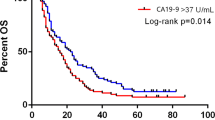Abstract
Aim
To assess the outcome of patients with resectable pancreatic adenocarcinoma (PA) associated with high serum CA 19-9 levels.
Methods
From 2000 to 2007, 344 patients underwent pancreatoduodenectomy for PA. Fifty-three patients (elevated group) had preoperatively elevated serum CA 19-9 levels (>400 IU/ml) after resolution of obstructive jaundice. Of these, 27 patients had high levels (400–899 IU/ml (HL)) and 26 patients had very high levels ≥900 IU/ml (VHL). Fifty patients with normal preoperative serum CA 19-9 levels (<37 IU/ml) comprised the control group.
Results
Median survival of the control group (n = 50) versus elevated group (n = 53) was 22 versus 15 months (p = 0.02) and overall 3-year survival was 32% versus 14% (p = 0.03). There was no statistical difference in the median and 3-year overall survival between patients with HL and VHL. Patients in the elevated group who normalized their CA 19-9 levels after surgery (n = 11) had a survival equivalent to patients in the control group.
Conclusions
Patients who normalized their CA19-9 levels postoperatively had equivalent survival to patients with normal preoperative CA 19-9 levels. Preoperative serum CA 19-9 level by itself should not preclude surgery in patients who have undergone careful preoperative staging.




Similar content being viewed by others
References
Ferrone CR, Brennan MF, Gonen M, Coit DG, Fong Y, Chung S, Tang L, Klimstra D, Allen PJ. Pancreatic adenocarcinoma: the actual 5-year survivors. J Gastrointest Surg. 2008;12(4):701–706. doi:10.1007/s11605-007-0384-8.
Olivié D, Lepanto L, Billiard JS, Audet P, Lavallée JM. Predicting resectability of pancreatic head cancer with multi-detector CT. Surgical and pathologic correlation. JOP 2007;9;8(6):753–758.
Farma JM, Santillan AA, Melis M, Walters J, Belinc D, Chen DT, Eikman EA, Malafa M. PET/CT fusion scan enhances CT staging in patients with pancreatic neoplasms. Ann Surg Oncol. 2008;15(9):2465–2471. doi:10.1245/s10434-008-9992-0.
White R, Winston C, Gonen M, D'Angelica M, Jarnagin W, Fong Y, Conlon K, Brennan M, Allen P. Current utility of staging laparoscopy for pancreatic and peripancreatic neoplasms. J Am Coll Surg. 2008;206(3):445–450. doi:10.1016/j.jamcollsurg.2007.09.021.
Karachristos A, Scarmeas N, Hoffman JP. CA 19-9 levels predict results of staging laparoscopy in pancreatic cancer. J Gastrointest Surg. 2005;9:1286–1292. doi:10.1016/j.gassur.2005.06.008.
Goonetilleke KS, Siriwardena AK. Systematic review of carbohydrate antigen (CA 19-9) as a biochemical marker in the diagnosis of pancreatic cancer. Eur J Surg Oncol. 2007;33(3):266–270. doi:10.1016/j.ejso.2006.10.004.
Boeck S, Schulz C, Stieber P, Holdenrieder S, Weckbach S, Heinemann V. Assessing prognosis in metastatic pancreatic cancer by the serum tumor marker CA 19-9: pretreatment levels or kinetics during chemotherapy. Onkologie. 2007;30(1–2):39–42. doi:10.1159/000097764.
Maithel SK, Maloney S, Winston C, Gönen M, D'Angelica MI, Dematteo RP, Jarnagin WR, Brennan MF, Allen PJ. Preoperative CA 19-9 and the yield of staging laparoscopy in patients with radiographically resectable pancreatic adenocarcinoma. Ann Surg Oncol. 2008;15(12):3512–3520. doi:10.1245/s10434-008-0134-5.
Ferrone CR, Finkelstein DM, Thayer SP, Muzikansky A, Fernandez-del Castillo C, Warshaw AL. Perioperative CA19-9 levels can predict stage and survival in patients with resectable pancreatic adenocarcinoma. J Clin Oncol 2006;20;24(18):2897–2902.
Montgomery RC, Hoffman JP, Riley LB, et al. Prediction of recurrence and survival by post-resection CA 19-9 values in patients with adenocarcinoma of the pancreas. Ann Surg Oncol. 1997;4:551–556. doi:10.1007/BF02305535.
Berger AC, Garcia M Jr, Hoffman JP, et al. Postresection CA 19-9 predicts overall survival in patients with pancreatic cancer treated with adjuvant chemoradiation: a prospective validation by RTOG 9704. J Clin Oncol. 2008;26(36):5918–5922. doi:10.1200/JCO.2008.18.6288.
Zhang S, Wang YM, Sun CD, Lu Y, Wu LQ. Clinical value of serum CA19-9 levels in evaluating resectability of pancreatic carcinoma. World J Gastroenterol 2008;21;14(23):3750–3753.
Smith RA, Ghaneh P, Sutton R, et al. Prognosis of resected ampullary adenocarcinoma by preoperative serum CA19-9 levels and platelet-lymphocyte ratio. J Gastrointest Surg. 2008;12(8):1422–1428. doi:10.1007/s11605-008-0554-3.
Halloran CM, Ghaneh P, Connor S, et al. Carbohydrate antigen 19.9 accurately selects patients for laparoscopic assessment to determine resectability of pancreatic malignancy. Br J Surg. 2008;95(4):453–459. doi:10.1002/bjs.6043.
Ong SL, Garcea G, Thomasset SC, et al. Surrogate markers of resectability in patients undergoing exploration of potentially resectable pancreatic adenocarcinoma. J Gastrointest Surg. 2008;12(6):1068–1073. doi:10.1007/s11605-007-0422-6.
Berger AC, Meszoely IM, Ross EA, et al. Undetectable preoperative levels of serum CA 19-9 correlate with improved survival for patients with resectable pancreatic adenocarcinoma. Ann Surg Oncol. 2004;11(7):644–649. doi:10.1245/ASO.2004.11.025.
Nakao A, Oshima K, Nomoto S, Takeda S, Kaneko T, Ichihara T, Kurokawa T, Nonami T, Takagi H. Clinical usefulness of CA-19-9 in pancreatic carcinoma. Semin Surg Oncol. 1998;15:15–22. doi:10.1002/(SICI)1098-2388(199807/08)15:1<15::AID-SSU4>3.0.CO;2-Z.
House MG, Yeo CJ, Cameron JL, Campbell KA, Schulick RD, Leach SD, Hruban RH, Horton KM, Fishman EK, Lillemoe KD. Predicting resectability of periampullary cancer with three-dimensional computed tomography. J Gastrointest Surg. 2004;8(3):280–288. doi:10.1016/j.gassur.2003.12.011.
Nieto J, Grossbard ML, Kozuch P. Metastatic pancreatic cancer 2008: is the glass less empty. Oncologist. 2008;13(5):562–576. doi:10.1634/theoncologist.2007-0181, Review.
Magnani JL, Nilsson B, Brockhaus M, et al. A monoclonal antibody-defined antigen associated with gastrointestinal cancer is a ganglioside containing sialylated lacto-N-fucopenteose II. J Biol Chem. 1982;257:14365–14369.
Ritts RE, Pitt HA. CA 19-9 in pancreatic cancer. Surg Oncol Clin N Am. 1998;7:93–100.
Heinemann V, Boeck S. Perioperative management of pancreatic cancer. Ann Oncol. 2008;19(Suppl 7):vii273–vii278. doi:10.1093/annonc/mdn450.
Yamaguchi K, Enjoji M, Tsuneyoshi MJ. Pancreatoduodenal carcinoma: a clinicopathologic study of 304 patients and immunohistochemical observation for CEA and CA19-9. Surg Oncol. 1991;47(3):148–154. doi:10.1002/jso.2930470303.
Nitsche M, Horstmann O, Christiansen H, Hermann RM, Hess CF, Becker H, Pradier O, Schmidberger H. Chemoradioimmunotherapy with 5-fluorouracil, cisplatin and interferon-alpha in pancreatic and periampullary cancer: results of a feasibility study. Cancer Radiother. 2008;12(8):817–821. doi:10.1016/j.canrad.2008.09.009.
Sanchez SE, Trevino JG. Current adjuvant and targeted therapies for pancreatic adenocarcinoma. Curr Med Chem. 2008;15(17):1674–1683. doi:10.2174/092986708784872348, Review.
Hernandez JM, Cowgill SM, Al-Saadi S, Collins A, Ross SB, Cooper J, Villadolid D, Zervos E, Rosemurgy A. CA 19-9 velocity predicts disease-free survival and overall survival after pancreatectomy of curative intent. J Gastrointest Surg. 2009;13(2):349–353. doi:10.1007/s11605-008-0696-3.
Author information
Authors and Affiliations
Corresponding author
Additional information
Turrini and Schmidt contributed equally to this work.
Rights and permissions
About this article
Cite this article
Turrini, O., Schmidt, C.M., Moreno, J. et al. Very High Serum CA 19-9 Levels: A Contraindication to Pancreaticoduodenectomy?. J Gastrointest Surg 13, 1791–1797 (2009). https://doi.org/10.1007/s11605-009-0916-5
Received:
Accepted:
Published:
Issue Date:
DOI: https://doi.org/10.1007/s11605-009-0916-5




